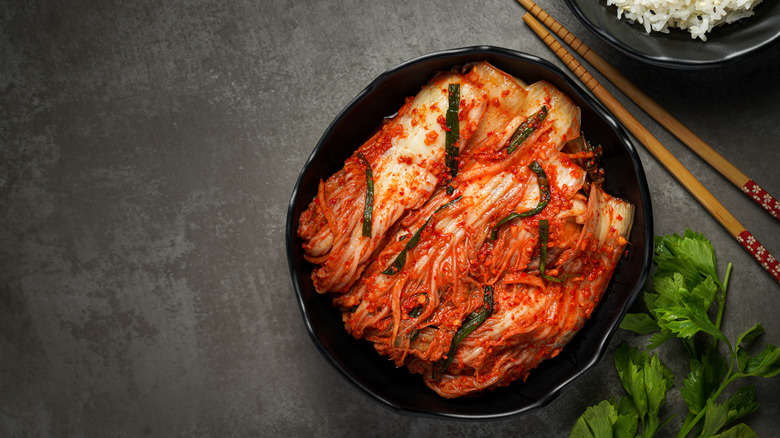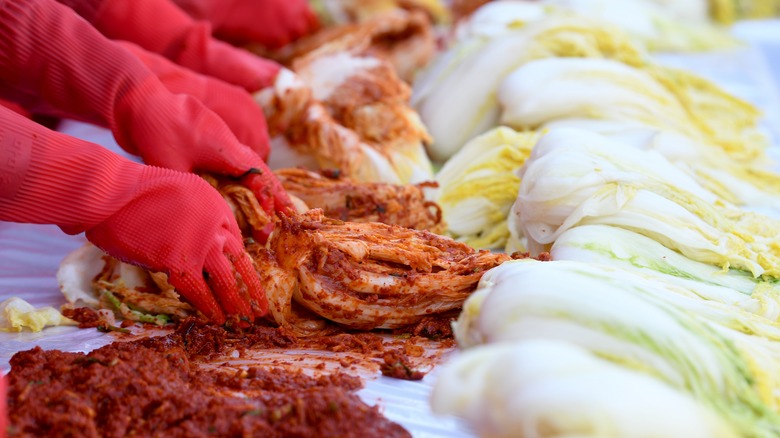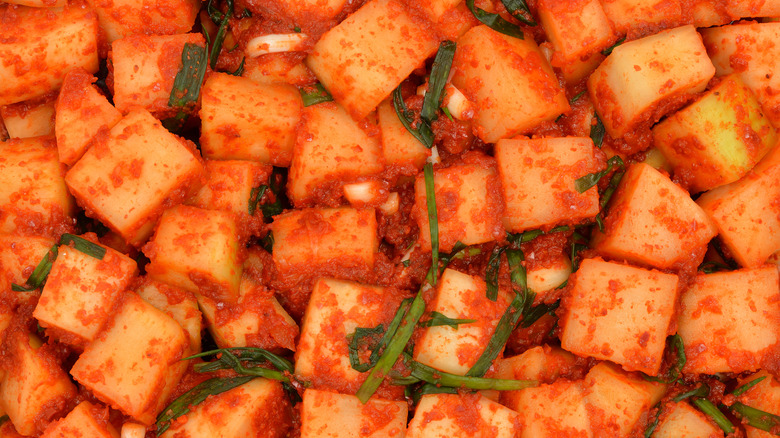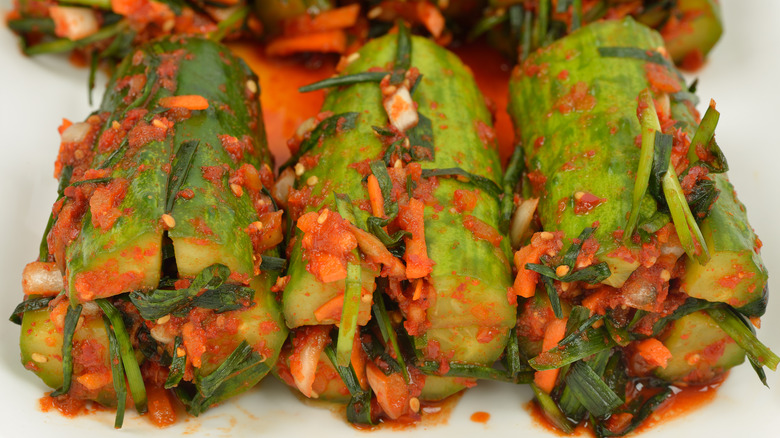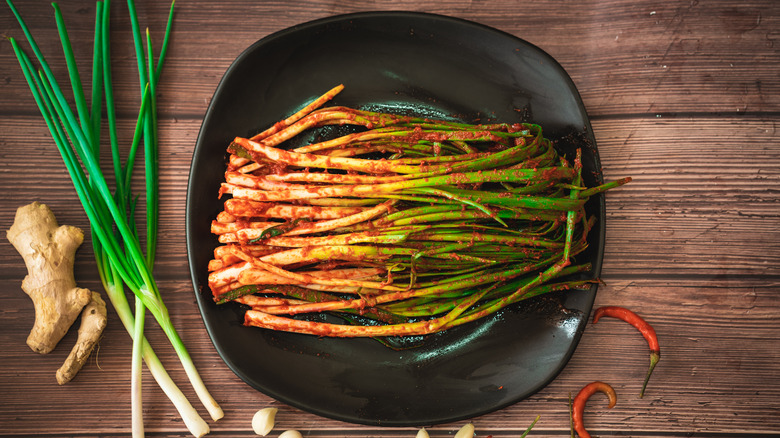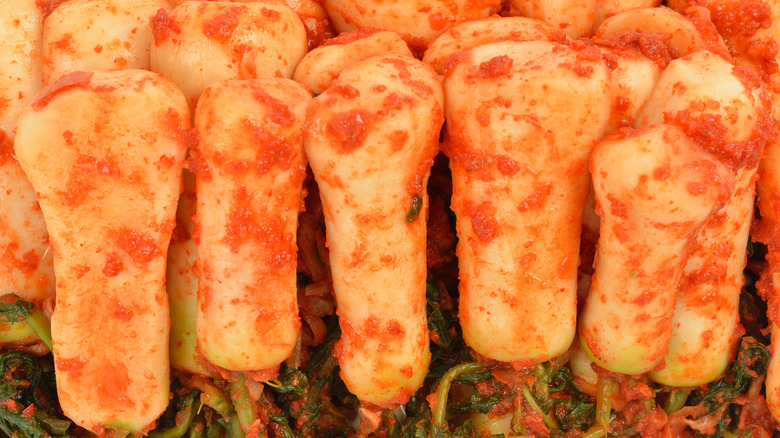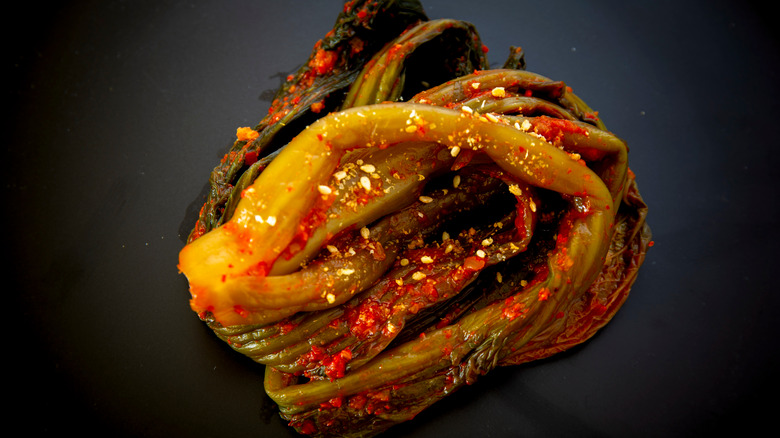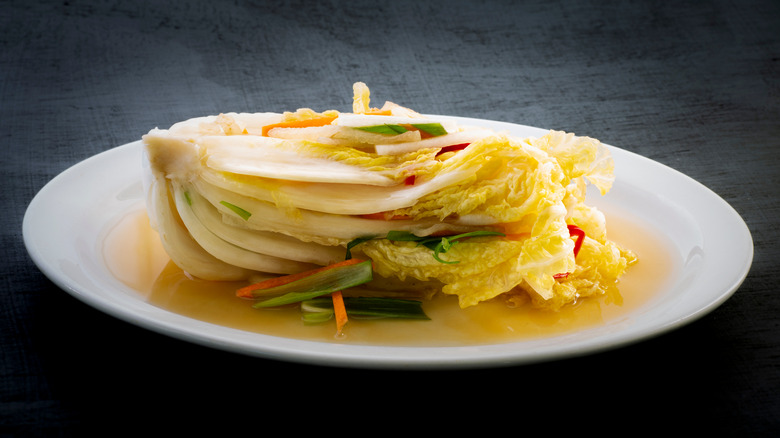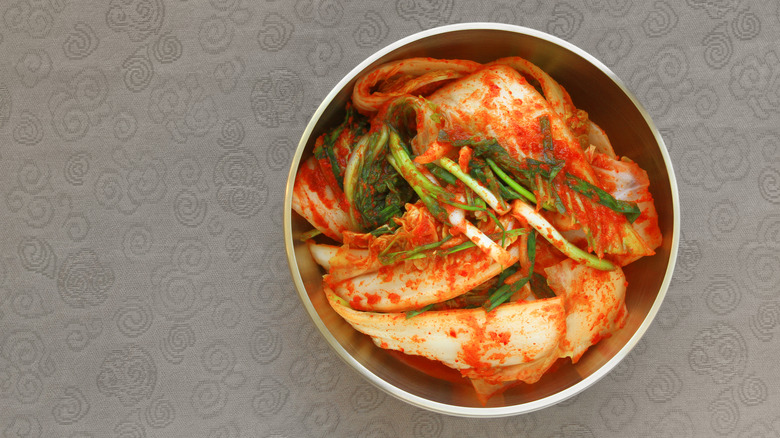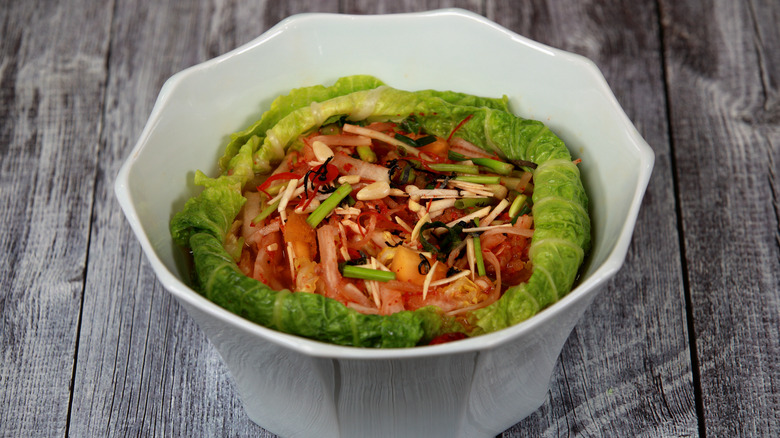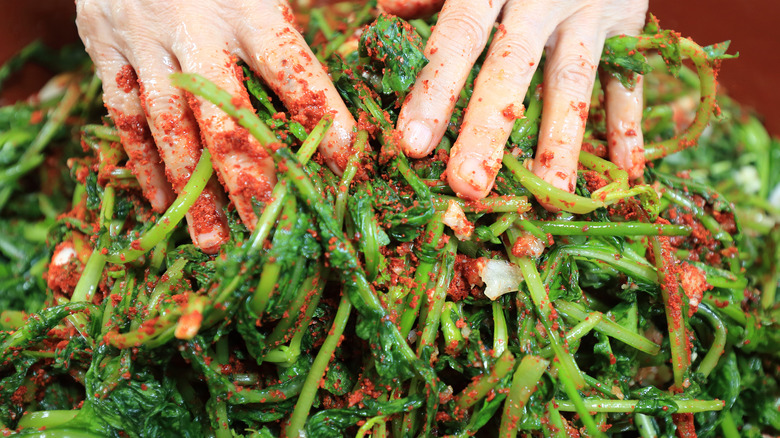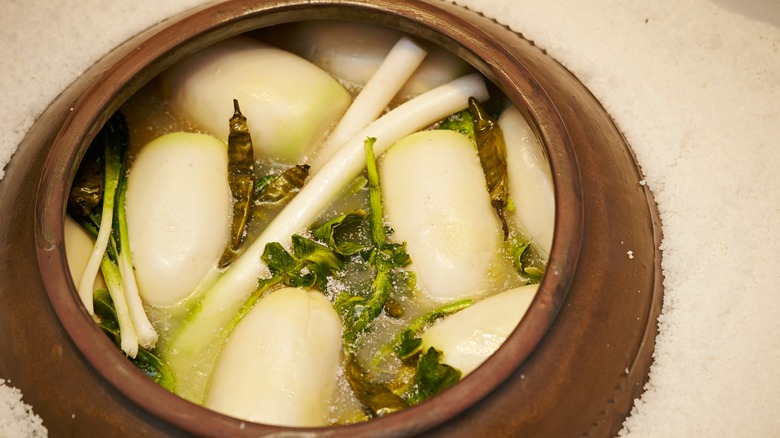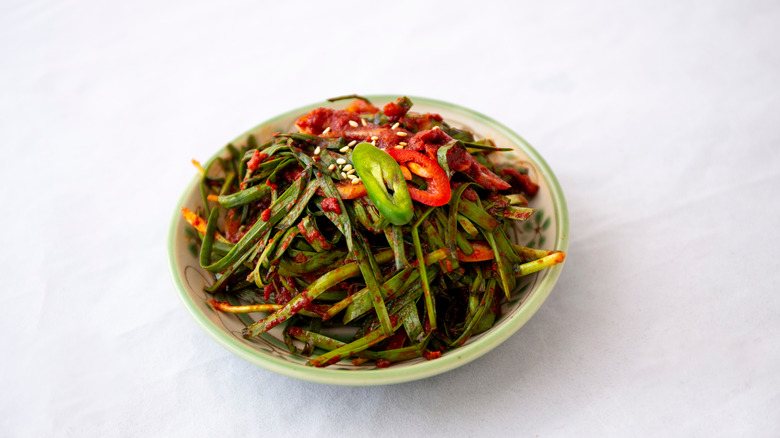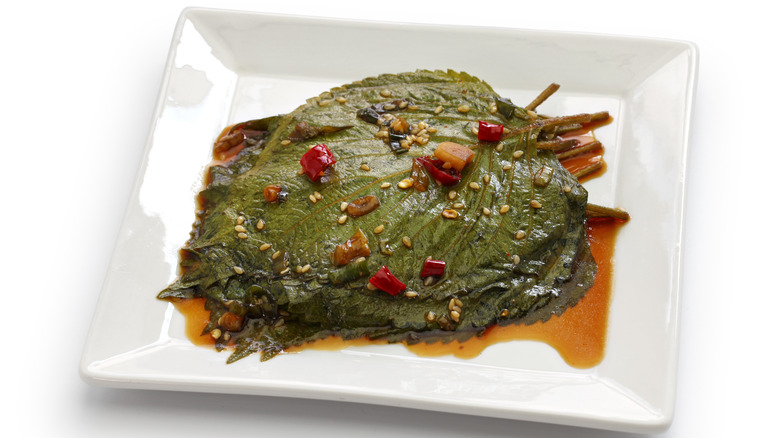14 Different Types Of Kimchi Explained
When you think of Korean flavors and cuikorsine, kimchi is probably one of the many foods that come to mind. However, kimchi is a lot more than a fermented mix of cabbage leaves in hues of fiery red. Kimchi is a category of side dishes made from pickled and fermented vegetables, of which many varieties with different tastes and textures exist (per BBC GoodFood).
Although when exactly kimchi came to be is a matter of debate amongst historians, says Bon Appétit, the tradition of making kimchi came from the need to preserve vegetables during the bitter months of winter in Korea when fresh produce was harder to find. Consequently, vegetables were salted, stored in earthenware, and placed underground to ferment and preserve. On The Gas also notes that though kimchi makers used salt for preservation, it was also added to aid digestion of carbohydrates in the carb-heavy Korean diet.
Theories reported in On The Gas suggest that the iconic hot red kimchi is a relatively new invention, a result of Korea's war with Japan in the 16th century, during which the spicy red pepper was introduced under the guise of Japanese mustard. This event is perhaps why there also exist chili-less, watery varieties of kimchi.
Needles to say, the varieties of kimchi go far beyond the presumed fermented mix of red chilies and cabbage. You may even be surprised to find that some types of kimchi don't need fermenting at all!
Baechu Kimchi
Baechu is perhaps one of the most popular types of kimchi. It is made from Napa cabbage and can be very time-consuming to create (via Serious Eats). Napa cabbage, South China Morning Post says, is a vegetable created from years of natural crossbreeding between southern China's bok choi cabbage and northern China's turnip.
To make baechu kimchi, Napa cabbage is quartered and given a long salt brine soak. Per Serious Eats, a slurry of gochugaru (the Korean chili flakes that provide a signature red hue), sticky rice flour, sugar, fish sauce, and saeujeot (salted shrimp) is mixed with vegetables. Daikon radish, scallions, carrots, and Asian pears are meticulously applied between each layer of cabbage leaves. The kimchi is then stored in jars and allowed to ferment. Because of its laborious process, baechu kimchi is often prepared in a communal event called kimjang. Recognized by UNESCO as a part of Korea's Intangible Cultural Heritage, each autumn, women in Korea gather to collectively prepare vast batches of kimchi that will last them through the winter.
Ideally, a two-to-three-week fermenting period gives baechu kimchi the right amount of acidic tinge while keeping the cabbage's crunch intact. The longer it ferments, the softer the cabbage becomes, and its heat and acidity begin to mellow. At this point, cooks can use the kimchi in fried rice, braises, and stews like kimchi jjigae. Writes Serious Eats, kimchi fermented for a shorter time is often eaten as a salad known as geotjeori.
Kkakdugi
Where baechu kimchi requires an arduous process of making rice and gochugaru slurry for layers of the Napa cabbage soaked in salt brine, kkakdugi, or radish kimchi is a more accessible variety of the fermented side dish. Per Serious Eats, to make kkakdugi, all that you need to do is chop radishes into chunks and massage them with a salt and gochugaru mix. Kkakdugi, for one, does not require a pre-soak in salt. Instead, the site reports that water will sweat from the salted root. The radish is watery enough to create a brine for fermentation.
Though kimchi makers can use daikon radish, the Korean moo radish is preferred by many when making kkakdugi (via The Subversive Table). With a subtle sweet taste, the firm radish gives kkakdugi a bit more crunch, juice, and tooth. Some prefer to make this kimchi in the later months of autumn during the radish harvest season in Korea (via My Korean Kitchen). Radishes harvested during this time tend to be even firmer and sweeter than usual, which some believe makes the best kkakdugi.
Although kkakdugi can go with pretty much any main dish, The Subversive Table writes that it goes particularly well with soupy foods like Korean chicken or oxtail soup (Dak Gomtang and Kkori Gomtang), Korean noodle soup (Kalguksu) as well as ox bone soup (Seolleongtang).
Oi Sobagi Kimchi
During the hot months of summer, other types of kimchi are often swapped for the cooling oi sobagi or cucumber kimchi (via San Antonio Current). Pronounced as oh-ee so-beh-gee, San Antonio Current writes oi sobagi is believed to be an older type of kimchi, sharing similarities between the Korean fermented cucumber and the 3,000-year-old pickled vegetables famously known as achar in India and Nepal.
Per Korean Bapsang, a popular method to make oi sobagi kimchi involves soaking cucumbers in salt brine and then making four incisions to create a pocket in each cucumber. Typically, Korean cucumbers are used to make the kimchi, but Kirby cucumbers are an equally good option when the former is unavailable. Then, a mixture of fish sauce, saeujeot, gochugaru, and Korean garlic chives or buchu is stuffed inside the cucumber. Crazy Korean Cooking says that an alternate (and easier) method to making oi sobagi kimchi is to slice up the cucumbers into smaller pieces and toss them in the spice mix.
Crazy Korean Cooking reports that oi sobagi is one of the few kimchi types that do not fare well under long fermentation periods. Serious Eats echoes this: Oi sobagi is enjoyable with a short time in the fridge, if not best when freshly prepared. When fresh, oi sobagi also lacks the funky smell that follows most varieties of long-fermented kimchi. With a nice balance of sweet, salty, spicy, and acidic flavors, oi sobagi is best eaten alongside a Korean BBQ on a hot and sunny day!
Pa Kimchi
Pa kimchi, also known as green onion kimchi is a breeze to make. Pa kimchi is typically produced and eaten during the months of spring when the Korean green onion called jjokpa is in season (via The Korean Herald). Jjokpa tends to be thinner than most green onions, with dark leaves and small white bulbs at the end. However, if you can't find this variety, then thin silpa scallions — tender versions of early-harvested standard scallions — are a solid alternative (via Korean Bapsang).
Korean Bapsang says that pa kimchi also relies on fish sauce and gochugaru for flavor, as well as sugar, garlic, and ginger. Sometimes, mareun ojingeo or dried squid are added to spice, create umami, and bring a chewy texture to contrast the green onion's crunch. Alternatively, fish sauce can be swapped with soy sauce for some vegan Korean food. Once the green onions are rubbed in the spice mix, The Korean Herald reports they can be tied together using their long stems for easier storing and eating. Alternatively, Maangchi chops the onions into smaller bite-sized pieces before mixing them with the spices.
Pa kimchi is also a type of kimchi that can be eaten right away, though sources say that letting it ferment for a couple of weeks will deepen the kimchi's spicy and robust flavor.
Nabak Kimchi
If you think that kimchi usually entails some vegetable slathered in a fermented chili paste, get ready for a surprise — there exist all sorts of mul kimchi, also known as water kimchi, in Korea (via Kimchimari). Nabak kimchi is a type of water kimchi that gets its name from nabak sseolgi, a technique of slicing vegetables into small, thin squares (via Korea Bapsang). Light squares of radish are sliced with this cutting method and floated in a watery broth to make nabak kimchi.
According to Beyond Kimchee, the water isn't the only thing about nabak that differentiates it from other kimchi. This kimchi lacks fish sauce and saeujeot while also calling for substantially less gochugaru. Instead, Beyond Kimchee writes that this spice-less kimchi is to be made by straining the spicy pepper in water and then pouring the red-colored broth over squares of vegetables and sliced Asian pear. Because the gochugaru is strained, the source reports that the spice only adds color to the kimchi rather than a punchy heat. Nabak kimchi lends itself more to the sweet and fruity taste of Asian pear instead.
Traditionally served on holidays, Korean Bapsang says nabak kimchi often goes alongside tteokguk — the New Year rice cake soup. With vermicelli, the kimchi can also be eaten as noodle soup or served alongside Korean barbecues.
Chonggak Kimchi
Chonggak kimchi comes from a very peculiar vegetable called chonggak or chonggakmu (via Taste Atlas). With small, round, curvy bulbs attached to long green steams, these radishes look like a topknot, and so, Taste Atlas says they also go by the name of ponytail radishes. According to Beyond Kimchee, in ancient cultural practices, single men in Korea tied their hair in long braids similar to the shape of the ponytail radishes. Upon marriage, the bachelors wore a bun instead, signifying the shape of the white bulb. This is why chonggak kimchi often goes by the name of bachelors kimchi as well!
Chonggak kimchi usually requires one week of fermentation time, according to Beyond Kimchee. The ponytail radishes tend to hold their crunch particularly well, despite soaking in tangy juices for a more extended period. If you can't get your hands on these radishes, any other radish similar in size is a suitable alternative — think the usual red radish, for example (via Insane In The Brine). A recipe from the cooking site lists these steps: Once the radishes have soaked in salt for a few minutes, knot the stems together. Then, each bulb is coated in a kimchi paste of rice flour, fish sauce, gochugaru, saeujeot, garlic, and ginger mix. After the fermentation period, the chonggak kimchi is ready to be served!
Gat Kimchi
Gat kimchi is made from a wild mustard leaf known as Jeolla Do mustard, appropriately named after the Jeolla Do province in Korea, where they are grown (via My Kitsune Cafe). Similar in texture to kale, the large and rough purplish Jeolla Do mustard leaves are crunchy and have a slightly bitter and loamy flavor. While these mustard leaves are often preferred to make gat kimchi, peppery Chinese mustard greens (or gai choy as they are known) can be used too (via Malaysian Chinese Kitchen). According to this recipe, of the two varieties of gai choy, the one with wide, luscious stems is chosen for gat kimchi.
As with the Napa cabbage used to make baechu kimchi, My Kitsune Cafe says the mustard greens must be allowed a long soak in saltwater brine first. Then, a rice flour slurry is mixed with the three aromatic kimchi ingredients — gochugaru, fish sauce, and saeujeot — plus vegetables such as carrots, chives, and scallions. The vegetable-spice paste is carefully applied onto each mustard green leaf before being allowed to ferment until it develops pungent and acidic flavors. As with most cabbage kimchi, My Kitsune Cafe says gat kimchi is served well alongside meats and stews.
Baek Kimchi
Baek kimchi is similar to nabak kimchi, as both lack spice in a world full of hot, red-colored kimchis. According to My Korean Kitchen, baek kimchi translates quite literally to white kimchi. Unsurprisingly, baek kimchi (made from Napa cabbage) is white, meaning it contains no gochugaru, per My Korean Kitchen. You could call it the antithesis of the fiery baechu kimchi. A mild taste makes baek excellent kimchi to give to elders, young kids, or to simply anybody who doesn't quite fancy spicy foods. Our source even mentions that baek is cooling alongside Korean BBQ.
While baek kimchi has no gochugaru, My Korean Kitchen reports that the use of fish sauce and rice flour is optional. Britannica lists common ingredients like Asian pears and nutty aromatics that create a fruity brine and give this kimchi a flavourful kick. Additionally, because baek kimchi requires so little, luxurious ingredients can shine here. Accordingly, ingredients like chestnuts and jujubes are often stuffed between Napa cabbage leaves in baek kimchi, per our sources. Some even claim that the lack of chili in this kimchi indicates that baek is far older than other varieties. Red spiced gochugaru supposedly came to Korea only post 16th century — long after kimchi was already being eaten in Korea .
Geotjeori Kimchi
Geotjeori or baechu geotjeori is simply baechu kimchi, except that it doesn't require any fermentation (via Korean Bapsang). Also known as the "fresh" kimchi because it can be eaten immediately, Korean Babsang reports that geotjeori is made during the summer — as opposed to late autumn for baechu kimchi — when Napa cabbages are much smaller, and their leaves are thinner.
Because this kimchi is eaten fresh as a salad and quickly after it is prepared, there are a few things to keep in mind when making geotjeori. According to the cooking site, a lack of fermentation means that the kimchi won't have time to develop a naturally sweet flavor. This is why sugar, corn syrup, or Korean rice syrup are added on top of gochugaru, saeujeot, and fish sauce. Korean Bapsang also says it is best to use tender cabbage leaves and keep the tougher ones out of the kimchi. Two Plaid Aprons also notes that, unlike baechu kimchi, which can be pretty laborious, in geotjeori, Napa cabbage is cut into small pieces and tossed in the spice mix, much like a salad.
Geotjeori can be stored for up to seven days but is ideally eaten fresh alongside noodle soups, Korean barbecues, oysters, and boiled pork, per Two Plaid aprons. Also, geotjeori can be eaten alone as a salad — a quick and delightful meal for kimchi fans!
Bossam Kimchi
Bossam kimchi is unique in both its preparation and its ingredients. According to Korea.net, varieties of kimchi vary by region and by the natural bounty of that area. The site says that bossam kimchi comes from Gaeseong, in the Gyeonggi-do Province of Korea, where fine ingredients such as pine nuts, jujubes, seafood, and pears are common. As a result, bossam or ssam kimchi, as it is also known, is thought to be an elegant delicacy made with luxurious ingredients.
Per KBS World, bossam kimchi is traditionally made with Gaeseong cabbage leaves, which are much wider than other varieties. KBS World writes that the leaves are left to soak in salt brine, after which, Korea.net suggests stuffing them with a filling of all sorts of seafood, including baby octopus and oysters, as well as nuts, green onions, mushrooms, ginseng, fruits, watercress, and other aromatics. The filling is mixed with the usual gochugaru, fish sauce, and saeujeot.
To assemble the bossam kimchi, KBW World details the process as such: The filling is scooped on top of a single leaf of cabbage which is then wrapped into a big bundle and served in a bowl. Because of the generous fillings used, Korea.net notes that bossam kimchi is often thought to be one of the more nutritious all kimchi varieties. The luxe ingredients place this kimchi as best left for special occasions and holidays.
Yeolmu Kimchi
Yeolmu kimchi is one of many cooling kimchis eaten during the summer months. According to Korean Bapsang, yeolmu is kimchi made from the long tender greens of young summer radishes that look thin and white with small roots. Korean Bapsang says young Napa cabbage, known as putbaechu or eolgari, is often added to the kimchi to accompany the young summer radish greens. When adding both greens, the site recommends a 2:1 ratio of radish to Napa cabbage — the kimchi is about the young radishes, after all.
When making yeolmu kimchi at home, a few small tricks can go a long way. Per Korean Bapsang, bruised radish greens can impart a grassy flavor to the kimchi, so it's best to handle them with care. Additionally, when the greens are soaked in salt, they can reduce to nearly half of the original volume. Korean Bapsang notes that you should be sure to account for the decrease in quantity when making a large batch of kimchi. Varieties of kimchi meant for colder months depend on a rice flour slurry, but Korean Bapsang says summer kimchis like yeolmu use wheat flour instead. The wheat flour will also reduce the earthy green flavor of the young radishes.
Another trick that Korean Bapsang suggests? Your summer kimchi can do with the bright flavor of fresh red chili peppers rather than the aged spice of gochugaru. Our sources say yeolmu kimchi can be eaten anytime after it is prepared, but letting it ferment for a couple of days will improve the flavor.
Dongchimi
Dongchimi belongs to the mul category of water-based kimchis made from Korean radish. While nabak kimchi is usually eaten from spring through till summer, Kimchimari says that dongchimi is meant to be eaten throughout winter and gets its name from dong, the Korean word for the chilly season. My Korean Kitchen notes that radishes harvested around fall and early winter for dongchimi can also be sweeter. In Korea, dongchimi is made around the time of the Onset of Winter, or Ipdong (via Korea.net). It is believed that the kimchi keeps getting better and better until the winter solstice (Dongji), when it is eaten along with a red bean porridge or as a cold noodles dish called naengmyeon.
Because dongchimi is meant to last through the winter months and so has an extensive preparation process. Sources like My Korean Kitchen write that, typically, whole radishes are used, requiring they be salted over several days before soaking in brine. The site follows that the fermentation period can take as long as several weeks, making for sturdy kimchi with a long shelf. However, their simple recipe offers a shortcut: Radishes can be sliced and turned into dongchimi in as little as two to three days.
As light as clear soup, My Korean Kitchen says dongchimi does tend to hold a slightly bitter flavor from the radish, though the fruity brine made from apples and Korean pears helps balance this out. Once fermented, the kimchi can be eaten as a refreshing appetizer, a cold noodle soup, or served alongside sweet potatoes and porridge, which is thought to help with digestion.
Buchu Kimchi
Buchu is another easy "first" kimchi to try your hands at if you're just entering the world of make-at-home fermented vegetables. Per Korean Bapsang, buchu, or garlic chive kimchi, is typically made with Korean garlic chives — more thin and tender than their Chinese counterparts. Buchu is a popular summer kimchi in the southern provinces of Korea.
With a more zesty, onion flavor, these garlic chives need very little to become kimchi — rice flour, gochugaru, fish sauce, and saeujeot, say our sources. Salted shrimp can even be substituted with an extra splash of fish sauce. Garlic chives don't need to be pre-salted either. Korean Bapsang says to massage the spice paste onto the garlic chives, allow them to ferment at room temperature for a couple of hours, and voilà! You have yourself tangy kimchi. Buchu kimchi can either be eaten within a few hours or allowed to sit for a couple of weeks. If allowed to ferment for longer, the flavor of the kimchi will develop a lot more.
Kkaennip Kimchi
Often interchanged with kkaennip jangajji or pickled perilla leaves (which use soy sauce for a sweet and garlicky flavor), kkaennip kimchi or perilla kimchi gets its garlicky but spicy flavor from gochugaru (via My Korean Kitchen). Even though kkaennip translates to wild sesame, No Recipes says that the leaf is more similar to basil and mint than sesame.
To make the kimchi, My Korean Kitchen details that a paste of gochugaru, fish sauce, and aromatics should are layered between each perilla leaf, placed in a container, and allowed to ferment for about a week. Kimchi makers can also add Asian pear to the paste to give the spicy kimchi a subtle tinge of sweetness, per No Recipes. This source also suggests that kkaennip seeds or sesame seeds are often sprinkled on top to add a crunch to the kimchi. Once fermented, kkaennip can be consumed in many different ways, including a banchan, a Korean side dish described by My Korean Kitchen. More commonly, however, a tiny bit of hot rice is placed onto each fermented leaf, the leaf is wrapped into a neat bundle and popped into the mouth for a light savory meal.
